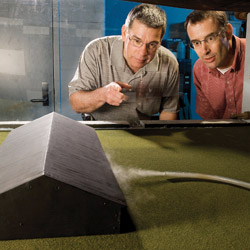Climate Change and Its Personal Impact

Climate change has become an everyday phrase, and there is hardly a week that goes by that doesn’t mention some aspect of climate change. With all of the current attention, the assumption that one could make is that climate change is a phenomenon that has just begun to occur and hasn’t happened before in history. The truth is that our climate has changed in the past, is changing now, and will change in the future.
Climate has never been constant. Climate is made up of a number of factors that impact our daily lives: temperature, precipitation, humidity and solar radiation (cloudiness). The question that arises in many conversations is “How does—and how will—climate affect my personal life?” The other question that occurs very frequently is how much of the current change in climate is caused by humankind. All of these are important questions that we ask in terms of the personal impact of climate.
If we look to the future, there is growing concern over rising temperatures and whether we can modify the rate of change. Looking back through time, we know that there were warm periods across the upper Midwest, and also periods in which it was a lot cooler, since much of the Midwest was covered with glaciers. The period we are undergoing happens to be a long-term warming trend with increasing variability.
A popular question is, “If the climate is warming, then why was this winter so cold?” Actually, one of the more important changes is that we are entering a period in which the climate is becoming more variable. We will endure larger swings in temperature and precipitation within a year in which we are likely to have warm or even hot periods followed by cooler periods during the summer and even colder winters. Annual precipitation totals have increased across the Midwest during the past 10 years and are expected to increase slightly, but what is more critical is that we can expect to have wetter springs.
The spring planting season that caused so much havoc in 2009 across Illinois and Indiana may become common, and, with the heavy rainfall, bring a chance of flooding. This type of rainfall pattern affects not only agriculture, but any activity in the spring in which wet conditions disrupt the normal activities. The climatic pattern is also expected to bring heavier and more intense storms, which will cause more runoff and erosion unless we make sure that the soil surface is protected, but could also challenge storm runoff systems in cities.
Temperature increases affects all of us. The increasing temperatures will add to plant stress and cause farmers to shift planting dates of their crops and select different hybrids or varieties that can handle these temperatures. This is a relatively simple change, but temperature is not in isolation from other climate variables. Warmer temperatures will cause plants to use more water to grow, and if rainfall is more variable, there is the chance of more water stress. This may create conditions in which agriculture production is reduced because of a combination of factors that occur within the growing season. These same effects will impact gardens as well as agricultural crops, and gardeners will have to be aware of these potential impacts.
One interesting aspect with the increasing temperatures is that the nighttime temperatures are warming faster than the daytime temperatures. This means that it will not cool off as much at night, which also affects plant growth and grain yields. Warmer temperatures cause plants to grow faster, but not necessarily be bigger or produce more fruit or grain. Warmer temperatures coupled with higher humidity levels will increase the stress on animals and humans. We will have to be aware of the potential impact of more high-temperature days, which will tax the electrical demand in our cities to provide power for air conditioning.
An interesting aspect that has occurred in plants with the rising carbon dioxide levels is that plant growth is increased because carbon dioxide is a basic building block of plants. This is a beneficial aspect of rising carbon dioxide levels. There are some negative aspects of rising carbon dioxide that have been observed in poison ivy. In poison ivy, there is an increased production of urushiol, the oil that causes the skin reactions, and these levels are expected to increase with increasing carbon dioxide. Poison ivy is expected to become more abundant and more toxic in the future. This is an aspect of climate change that is not mentioned very often but could impact many of us.
Climate change will impact all of us and there are many segments of our life that may be affected. We tend to think that climate change occurs somewhere else and impacts someone else. In reality, it touches each of our lives and we need to understand what the implications are for our particular business. iBi
Jerry L. Hatfield is the laboratory director of the USDA-ARS National Laboratory for Agriculture and the Environment in Ames, Iowa.

